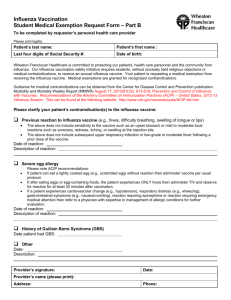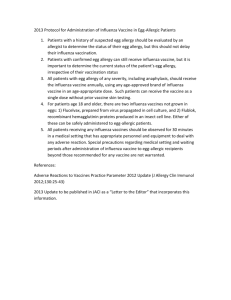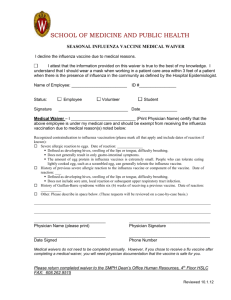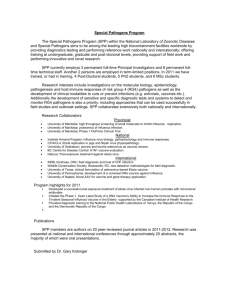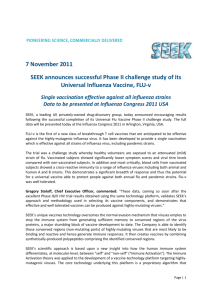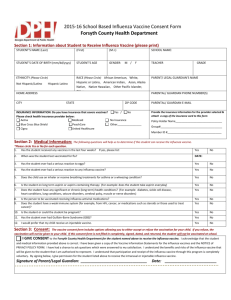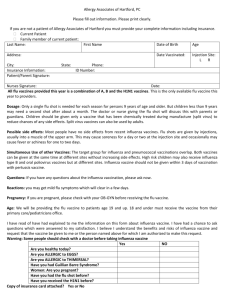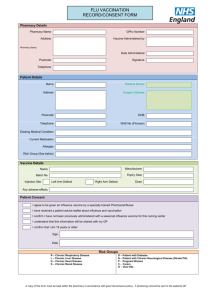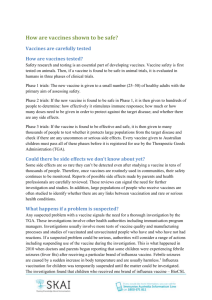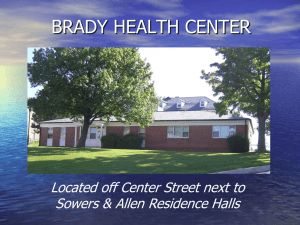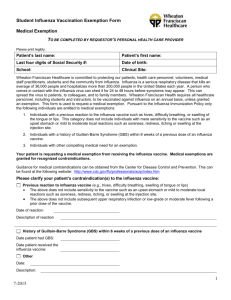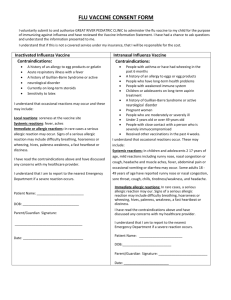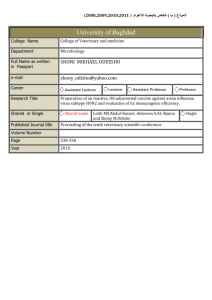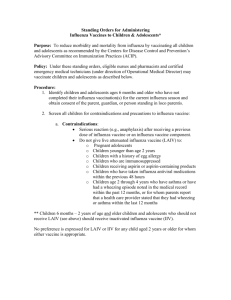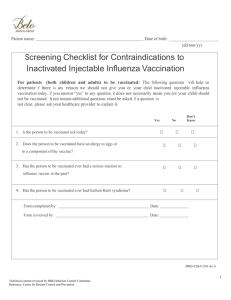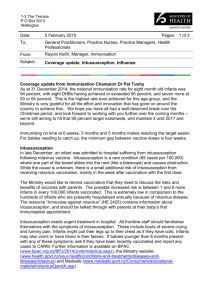Erin Deere NRS 222 10/29/15 Vaccine Clinic Evaluation Today, I
advertisement
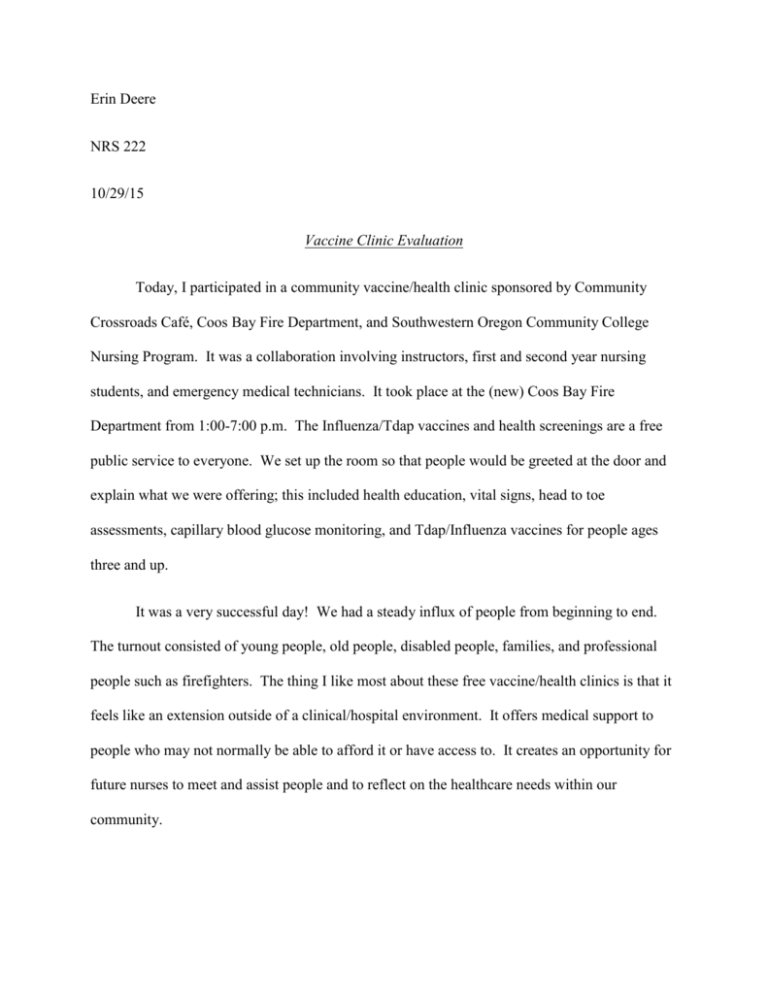
Erin Deere NRS 222 10/29/15 Vaccine Clinic Evaluation Today, I participated in a community vaccine/health clinic sponsored by Community Crossroads Café, Coos Bay Fire Department, and Southwestern Oregon Community College Nursing Program. It was a collaboration involving instructors, first and second year nursing students, and emergency medical technicians. It took place at the (new) Coos Bay Fire Department from 1:00-7:00 p.m. The Influenza/Tdap vaccines and health screenings are a free public service to everyone. We set up the room so that people would be greeted at the door and explain what we were offering; this included health education, vital signs, head to toe assessments, capillary blood glucose monitoring, and Tdap/Influenza vaccines for people ages three and up. It was a very successful day! We had a steady influx of people from beginning to end. The turnout consisted of young people, old people, disabled people, families, and professional people such as firefighters. The thing I like most about these free vaccine/health clinics is that it feels like an extension outside of a clinical/hospital environment. It offers medical support to people who may not normally be able to afford it or have access to. It creates an opportunity for future nurses to meet and assist people and to reflect on the healthcare needs within our community. According to the Center for Disease Control and Prevention an estimated 36,000 deaths occur each year due to the Influenza virus (CDC). Influenza is a highly contagious virus that affects people of all ages all around the world. However the populations most negatively affected are children under the age of two, elderly, and medically compromised people. Symptoms of Influenza include high fever, sore throat, cough, headache, fatigue, and muscle aches. The influenza vaccine is recommended to children ages six months to eighteen years old, adults over fifty, health care personnel, people in congregated living, people at risk for medical complications, and all healthy adults. Vaccines are developed every year based off of major known seasonal strains of influenza. Influenza vaccines are the most effective prevention strategy. They are 70-90% effective in preventing Influenza in healthy adults when matched with the current seasonal strains, can provide cross protection against similar strains resulting in reduced severity of symptoms, and reduce transmission of the virus. It also decreases the risk for secondary complications related to Influenza. Along with the vaccine, avoiding exposure to the virus and good hand hygiene are also very important in prevention (Wilkinson & Treas, 2011). While administering vaccines, it is important to take several safety precautions. The first year students gathered vital signs and medical history from the client including vaccine history and drug/food allergies. The client was also educated about risks of vaccine reactions varying from mild to severe and provided with a CDC vaccine information statement. During vaccine administration, triple checks and aseptic techniques were performed for the safety of the client, as well as the student nurse. In the final phase of the process, clients were asked to stay for 1015 minutes to monitor for reactions such as hives, dizziness, or anaphylactic shock. They were offered a resting chair, juice or water, and cookies. Every single client was very appreciative for the service provided. Our instructor, Melissa Sperry, asked that the second year students write about our experience in a leadership role. I was very honored to be asked to help with the vaccine/health clinic and was even more enlightened playing a leadership role. When we arrived, Melissa asked that we organize and delegate how first year student nurses and emergency medical technicians could help. Breanne and I collaborated a work flow that was organized, efficient, and client friendly. Each station was set up and communication between everyone was great. The most successful part was how smoothly each transition was from station to station and how everyone helped each other. Teamwork is critically important and we were very successful. It was really enjoyable spending time with first year students answering questions and providing encouragement. The emergency medical technicians were amazing. They were helpful, skillful, funny, and had excellent communication skills with each client. The Coos Bay Fire Department was also incredibly helpful by providing a clean and safe working environment, as well as volunteering in allowing students to “practice” on them. Over all, it was a wonderful experience and I would gladly do it again. I love seeing this community come together for the greater good of all people and that is why I love being a nurse. Community outreaches are awesome!! References: Wilkinson, J., & Treas, L. (2011). Fundamentals of Nursing (2nd edition). Philadelphia, PA. F.A. Davis Company.



